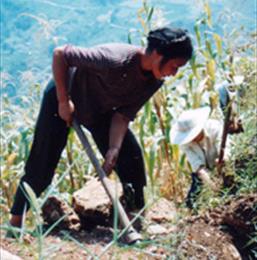Rural Energy Projects
From 1997 until today, with the help of many organizations and individuals, DORS has implemented rural energy projects (including fuel-efficient stoves, solar panels and biogas systems, etc.) in 20 villages in Hanyuan and Ganluo counties. Starting and pushing forward these types of projects has reduced the amount of fuelwood that villagers collect, the time spent doing this, and labor expended. While reducing the burden on the environment, at the same time we have introduced cleaner energy sources, also creating cleaner and more sanitary living conditions. We hope through these new energy sources to bring villagers more convenience.
Fuel-Efficient Stoves Project
Starting from the year 2000, in Huodi village, Nimei township, where we built the first fuel-efficient stove, until March 2007, DORS has completed 1047 stoves in 20 villages, training 59 people in the construction process. 4535 villagers have benefited from the project, and the project altogether has spent 339,648 yuan. Of this, villagers contributed 50,112 yuan, and DORS contributed 289,536 yuan.
Most of the villages in which DORS works are quite remote, not to mention at elevations of at least 1600-2200 meters. There transportation is not convenient at all, economic development is slow, and villagers mainly depend on burning firewood to cook and stay warm. Usually they require 2-4 hours by mountain roads to reach, and added to that some of our villages are Yi minority villages, which have special fire-based customs, so many of the villages end up having to go ever further to cut firewood. Sturdy firewood is ever harder to find as well. In some villages where the labor force is insufficient, the whole family has to go on a firewood-gathering expedition together. The mountain roads are not easy to hike, the large-diameter wood available is located in inaccessible areas, and villagers are often hurt in the process of collecting wood. Usually, only villagers in good financial situations and with access to convenient transportation can afford to buy coal to cook with. As a result, DORS decided to implement fuel-efficient stoves projects, on one hand, from liveilhood considerations, to reduce villagers’ labor and burden, and on the other hand, to reduce the harm to forests and the environment.
For example the first village to implement fuel-efficient stoves projects, Huodi (Yi minority): they need to spend about 3 months out of the year each year on the mountains collecting firewood. Traditionally, Yi minority villagers all make fires on the floor of the living room of their houses, scraping a hollow in the floor, and around it arrange three metal or stone prongs (called a three-prong stove), which then is convenient to cook on or stay warm. There is nowhere for smoke to escape from the room, and smoke fills it. Therefore, fuel-efficient stoves were born.
We hired the County Energy Office’s technician to give us technical support. He went together with us to the villages, discussing with villagers the design, structure, and basic knowledge related to the fuel-efficient stoves. In order to reduce costs, we do our best to use locally available materials to construct the stoves.
Project Effectiveness
The difference compared with the old stoves is this: for one, the new stoves have a chimney, and smoke can be directed outside; the stoves’ inside is changed, allowing oxygen to enter from outside during the burning process, so the temperature of the fire rises, and it saves time and firewood from cooking things at low heat for many minutes. The new stoves:
1. Reduce the pressure of villagers on the ecological environment, by reducing the amount of wood cut. Constructing fuel-efficient stoves saves nearly one half of the fuelwood (on average every household can save 3000-5000 jin per year), to a certain degree solving the difficulty of gathering firewood problem, at the same time also reducing the time spent collecting it and the labor (previously it averaged over 100 laboring days, now it has been reduced by about 1/4 of the time).
2. Save time. Time spent cooking meals or cooking pig feed has now been reduced by 1/2 or 1/3.
3. Are clean, neat and sanitary, and beneficial to villagers’ health, because the surface of the stoves is tile; especially benefit women, because they avoid a roomful of smoke which harms women’s health and their eyes;
4. Train villagers in construction. The technician for the project is only in charge of technical training—he doesn’t actually construct the stoves, instead, he gives this opportunity to the villagers in order to let them participate directly and at the end have a new skill, the construction of fuel-efficient stoves. This is beneficial to us in that once the project is finished and we’ve left, villagers can solve problems with stoves themselves, and can go outside the village and earn money with their new skill.
The fuel-efficient stoves project has been successful—villagers’ interest in building the stoves now speaks for itself. After completing the project, presently there are 10 villages which have applied to DORS hoping we will once again support this project.
Solar power project (experimental)
Solar power projects are in order to solve local electricity problems. In certain places the situation is that the local electricity grid can’t be connected to and the area is not suitable for a small water-powered generator. Although in the beginning of the project’s implementation we did training, because this project’s cost and technical skill requirements were high, the project end-period maintenance was hard to do, we only did experimental projects in two villages, and didn’t continue it.
Biogas Project
As of March 2007, we’ve started biogas projects in two project villages. DORS is preparing to expand this project to many project villages this year, and really promote this project. This project’s advantages are in: Reducing consumption of traditional energy sources (and thus conserving the environment), and making the kitchen more sanitary and improving quality of life.
Project Effectiveness
1. Reducing the pressure on the ecological environment. Tree-cutting will be reduced by 1500 kilograms of firewood per year by this project (if biogas and fuel-efficient stoves are used together, the saving effect will be magnified). If calculated according to each year one mu of land being able to produce 10,000 kilograms of trees, then these fuel-efficient stoves/biogas systems will be able to save the cutting of forest by 15%.
2. Improving the villagers’ living environment, by increasing the quality of life. Biogas is a clean energy source, and the contents of the container after fermenting become a yet more beneficial fertilizer for the crops’ growth. Biogas can be used for cooking and even for light. It makes the kitchen cleaner, as there’s no need to pile up huge amounts of brushwood, etc.
3. Saving labor. Biogas can save about 1/4 of the firewood-collecting time yearly, thus saving labor and time which villagers can use going outside to find temporary work or doing other activities which actually generate income.
4. Training villagers in the construction technology of biogas systems, gives the project sustainable strength.


